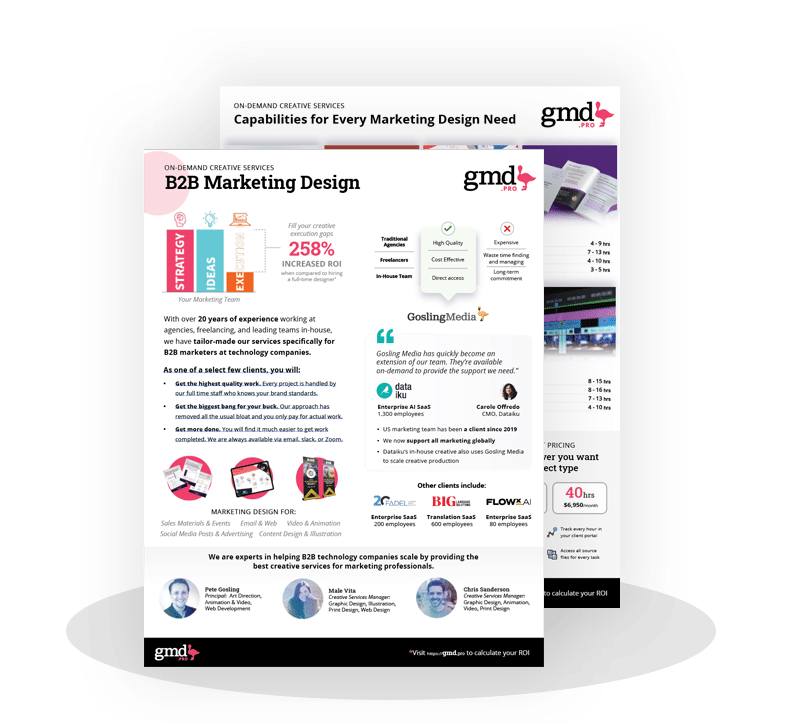Scaling B2B design projects can feel overwhelming, especially when adding more staff isn’t an option. Here’s how to optimize your current team and resources to get more done without increasing headcount:
- Build a Design System: Create reusable components and standards to streamline workflows. Tools like Figma or code-based systems can save time and improve consistency.
- Use Automation Tools: Automate repetitive tasks with tools like Artwork Flow, Relay.app, or ClickUp to free up your team for creative work.
- Fix Workflow Problems: Identify and address bottlenecks using Agile methods and tools like Kanban boards to improve efficiency.
- Smart Outsourcing: Delegate tasks like UI/UX design or branding to external experts for specialized support without overloading your team.
- Improve Team Skills: Upskill your team with affordable platforms like Coursera or Skillshare, and cross-train them for greater flexibility.
- Use Project Management Software: Tools like Asana or monday.com help organize tasks, track progress, and manage workloads effectively.
- Create Reusable Design Elements: Modular design libraries speed up projects while maintaining quality and consistency.
Quick Overview:
| Strategy | Key Benefit |
|---|---|
| Design System | Consistency and faster workflows |
| Automation Tools | Reduced manual tasks |
| Fix Workflow Problems | Streamlined processes |
| Smart Outsourcing | Specialized expertise |
| Improve Team Skills | Versatile, skilled team |
| Project Management Software | Better organization and tracking |
| Reusable Design Elements | Faster project delivery |
1. Build a Design System
Design System Basics
A design system serves as your team’s go-to resource for creating consistent and scalable B2B designs. Think of it as more than just a style guide – it’s a collection of reusable components and standards designed to streamline application development. Research shows that 60% of businesses rely on enterprise design systems, with 68% attributing their revenue growth to consistent branding. This approach becomes especially important when you need to scale your design operations without adding more team members.
Setting Up Your Design System
Building a functional B2B design system starts with careful planning. Leading companies structure their systems around these core components:
| Component | Purpose | Impact |
|---|---|---|
| Design Repository | Stores visual components and patterns | Ensures consistent access to assets |
| Style Guide | Defines brand standards and usage rules | Protects brand integrity |
| Component Library | Contains reusable UI elements | Speeds up development |
| Documentation | Explains how to use and implement assets | Simplifies team adoption |
These elements create the backbone of a design system that can grow as your business scales.
"Design systems are a full-time job, and we can’t expect our teammates to keep volunteering their time forever! So continue pushing for resources and looking ahead to the future. Think long term."
– Andrea Nguyen, Product Designer
The key to success lies in establishing a single, reliable source for all design assets. Many teams choose between Figma or code-based systems. Figma allows for easier updates but requires more quality control, while code-based systems ensure components are accurately represented but demand more maintenance.
Time-Saving Results
A well-implemented design system can significantly improve team efficiency. According to a Figma study, designers completed tasks 34% faster, and design teams reduced work hours by 31%, all while improving quality by 18% compared to traditional methods. This efficiency not only saves time but also cuts costs. For instance, Lloyds Bank saved around $250,000 per project by adopting a design system. Additionally, web page development becomes 10–20 times faster when using a well-organized pattern library.
"A shared language is fundamental to collaboration, and that’s exactly what an effective design system provides. It gives people the tools and processes to create things together."
– Alla Kholmatova
2. Use Automation Tools
Best Design Automation Tools
Over 65% of design agencies now rely on AI automation – up 40% since 2023 – to handle repetitive tasks, allowing teams to focus on more creative and strategic work.
Here’s a side-by-side look at some of the top-rated design automation tools for B2B teams:
| Tool | Key Features | Best For | G2 Rating |
|---|---|---|---|
| Artwork Flow | Brand asset automation, approval workflows | Enterprise design teams | 4.8/5 |
| Relay.app | AI-powered workflow automation | Cross-team collaboration | 4.9/5 |
| ClickUp | Design project management, asset library | All-in-one design management | 4.7/5 |
| Make | Visual workflow automation | Custom automation sequences | 4.7/5 |
"Workflow automation tools that seamlessly integrate with existing tools empower businesses to streamline operations, reduce manual errors, and enhance efficiency. By automating routine tasks and facilitating data flow between platforms, these tools not only save valuable time but also unlock new levels of productivity and innovation."
– Zach Dannet, Tumble Co-Founder
These tools don’t just simplify processes – they also deliver measurable time savings, as shown below.
Measuring Time Saved
Automation tools can make a noticeable difference. A case study by Alenikos revealed that a mid-sized design agency achieved:
- A 40% reduction in project delivery time
- A 35% boost in client satisfaction
- A 25% increase in profit margins
- A 60% cut in time spent on routine tasks
To achieve results like these, consider the following strategies:
-
Task Assessment: Map out your workflows to identify repetitive tasks that can be automated. Common examples include:
- Generating style guides from existing brand assets
- Expanding color palettes
- Adjusting responsive designs
- Offering layout suggestions
- Applying brand elements
- Implementation Strategy: Start with simple tools and gradually scale up. Train your team to ensure they fully utilize the tools’ capabilities.
-
Integration Planning: Choose tools that integrate seamlessly with your current tech stack to avoid duplicate work and maximize efficiency. Look for features like:
- Automatic project timeline generation
- Resource allocation automation
- Real-time collaboration
- Smart element placement
Recent data shows that nearly 90% of users trust these tools to handle tasks accurately and help make faster, more informed decisions.
3. Fix Workflow Problems
Identifying Workflow Issues
Spotting workflow bottlenecks is crucial for improving efficiency. When these issues go unchecked, they can negatively impact revenue, client satisfaction, and team morale.
Here are some areas to focus on when identifying problems:
| Analysis Type | What to Monitor | Key Metrics |
|---|---|---|
| Process Flow | Task completion rates | Throughput time, lead times |
| Resource Usage | Team capacity | Utilization rates, overtime hours |
| Quality Control | Error rates via revision requests and client feedback | Revision requests, client feedback |
| Communication | Information flow | Response times, handoff delays |
For example, analyzing cycle times might reveal that while individual tasks take 10-12 minutes, review stages are causing delays. Solutions like automated notifications and streamlined approval processes can help reduce these delays significantly.
Applying Agile Methods
Agile principles can make workflows more efficient. Many modern B2B design teams are turning to agile methods to boost productivity without needing to expand their teams.
Some effective agile practices include:
- Breaking large projects into smaller, manageable sprints
- Holding daily stand-ups to track progress
- Using Kanban boards for visual progress tracking
- Running retrospectives to improve processes
Design collaboration tools like Asana, which features Kanban boards and automated reminders, can make it easier to pinpoint bottlenecks and keep projects on track.
To make agile practices work for your team, try these approaches:
- Use real-time design review tools for continuous feedback
- Clearly define roles and assign responsibilities
- Automate routine tasks to save time
- Keep a centralized repository of templates and best practices
Incorporating these agile methods will help set the stage for scaling your design projects effectively.
How to Scale up your design team using BIM Automation
sbb-itb-3ff8c64
4. Smart Outsourcing
Once you’ve streamlined your internal workflows and incorporated automation, consider outsourcing specific design tasks to take your strategy further.
What to Outsource
Focus on outsourcing tasks like UI/UX design, web design, brand identity, and digital ads.
| Task Type | When to Outsource | Benefits |
|---|---|---|
| Brand Identity | Need consistency at scale | Saves time, ensures a unified look |
| UI/UX Design | Require specialized skills | Improves user experience |
| Digital Ads | High-volume requirements | Quicker turnaround times |
| Web Design | Need a new perspective | Brings fresh ideas |
For example, ServiceNow partnered with Content Beta to update design assets, aligning thousands of presentations and documents with their new branding. This move not only maintained high design standards but also saved them $580,000–$600,000 annually in operational costs.
Managing External Designers
To ensure outsourced projects run smoothly, follow these steps:
-
Create Clear Design Briefs
Your brief should include key details like your company profile, target audience, competitors, project goals, and specific design requirements. -
Set Up Communication Protocols
As one expert puts it:"Look for somebody that has a really clear outlined process. Somebody that lets you know from the beginning what’s going to happen and when".
-
Organize Design Resources
Keep all essential assets – logos, brand colors, typography, style guides, and past designs – in a centralized repository for easy access.
These practices help you manage outsourced teams effectively and prepare for choosing the right service model.
Design Service Options
B2B design services often provide flexible plans to suit your needs. For instance, Gosling Design Studio offers month-to-month agreements with predictable pricing and rollover hours, starting at $1,975 per month for 10–40 studio hours.
Another example is Halo Lab’s redesign for Catalyze AI. Their custom interface and intuitive navigation resulted in higher user engagement.
When evaluating potential providers, consider factors like:
- Industry expertise
- Quality control processes
- Data security measures
- Scalability options
- Communication standards
- Cultural alignment
These considerations will help you find a service model that supports your team’s goals and scales as needed.
5. Improve Team Skills
Boost your team’s productivity without adding new hires by focusing on targeted training and cross-training efforts.
Budget-Friendly Training Options
You don’t need a big budget to upskill your team. Free and affordable online courses can make a big difference. For instance, the University of Colorado offers a graphic design course on Coursera at no cost.
Here are some popular training platforms to consider:
| Platform | Features | Cost |
|---|---|---|
| Coursera | Full course access, practice exercises | Free with "audit" option |
| Skillshare | Design software tutorials, project-based learning | Free trial, then $25/month |
| Pluralsight | Technical design courses, skill assessments | Free trial, then $29/month |
| CreativeLive | Expert-led design workshops | $25/month subscription |
Tips for Effective Training:
- Create a Skills Matrix: Assess your team’s current skills and track their progress. For example:
| Skill Area | Beginner | Intermediate | Expert |
|---|---|---|---|
| UI Design | 2 team members | 3 team members | 1 team member |
| Typography | 1 team member | 4 team members | 1 team member |
| Design Systems | 3 team members | 2 team members | 1 team member |
- Develop Training Plans: Build tailored learning paths to close skill gaps and monitor progress weekly.
While structured training strengthens foundational skills, cross-training ensures your team can handle a variety of tasks, making your projects more flexible and scalable.
Why Cross-Training Matters
Cross-training allows team members to step into different roles, improving adaptability and efficiency. As Tim Sheiner puts it:
"Design standards is about a culture of doing the simplest effective thing. Effective means that delivering a useful solution to the problem is a must-have. Simplest means you want to do it in the most efficient way possible".
A practical example highlights the impact of cross-training: A five-person team managing ten products introduced a cross-training program. By the end of the quarter, each member was skilled in three additional products, enabling the team to take on three more projects without hiring.
Key Benefits of Cross-Training:
- Smooth handling of absences
- Better use of resources
- Increased motivation through skill variety
- Stronger problem-solving skills
- Improved team collaboration
How to Make Cross-Training Work:
- Schedule regular skill-sharing sessions
- Use pair programming for knowledge sharing
- Document processes for easy reference
- Track progress with weekly assessments
- Set clear goals and deadlines for training
This approach not only builds a more capable team but also ensures they’re ready to tackle new challenges efficiently.
6. Use Project Management Software
Project management software helps design teams handle growing workloads effectively, keeping things organized from start to finish without needing to add more team members. It works hand-in-hand with earlier strategies to ensure smooth execution.
Tools for Design Teams
Choosing the right project management tool is crucial for supporting creative workflows. Here’s a quick look at some popular options for B2B design teams:
| Software | Best For | Key Features | Starting Price |
|---|---|---|---|
| Asana | Visual project planning | Tailored workflows, clear timelines | $10.99/user/month |
| monday.com | Workflow automation | Design templates, time tracking | $8/user/month |
| Miro | Design collaboration | Whiteboard tools, asset library | $8/user/month |
Stay on Top of Progress
Keeping track of progress is essential for scaling output while maintaining quality. Here’s how to do it:
- Use project templates to outline design requirements, asset specs, review steps, and key milestones.
- Centralize discussions with built-in collaboration tools to cut down on email clutter and keep everyone on the same page.
- Leverage time tracking and deadline reminders to monitor task durations and manage resources effectively.
Features to Look For
- Time tracking and reminders
- Visual timelines for better scheduling
- Customizable task boards to fit your team’s needs
Pro Tip: Test the free version of a tool first to see if it aligns with your team’s workflow before committing to a paid plan.
7. Create Reusable Design Elements
Reusable design elements can save time and streamline workflows by cutting out repetitive tasks. Unlike full-scale design systems, these focus on modular components, making it easier to complete projects efficiently while making the most of your team’s resources.
Understanding Modular Design
Modular design breaks projects into smaller, reusable pieces. This approach ensures consistent branding, speeds up development, and improves quality control. US Bank’s experience underscores its importance.
"It’s really the foundation of everything that you’re doing around customer experience, from code to design", says Shawn Sheely, Former VP Head of Experience Technology and Enterprise Accessibility at US Bank.
Building Design Libraries
Start small with basic items like buttons and icons, then expand to more complex components. As Kim Brooks, Product Designer for the Design System Squad at Alcumus, points out:
"Reusable design components eliminate the need to start from scratch with every new project. This accelerates the design process, allowing designers to focus on refining and tailoring elements rather than reinventing them".
Key steps for building an effective design library include:
- Use clear naming conventions for all components.
- Document usage guidelines, covering details like colors, typography, and spacing.
- Create variations for different scenarios but avoid unnecessary duplication.
- Incorporate accessibility standards from the beginning.
A well-maintained library not only ensures consistency but also speeds up project timelines.
Speed Up Project Delivery
One company saw a 70% drop in costs and a 70% boost in onboarding rates after three years of using a reusable design system. To make the most of this approach:
- Centralize your library for easy access.
- Use auto-layout tools for responsive components.
- Regularly update your library.
- Test components in real-world scenarios.
"The smart phone screen really drove us toward simplicity. And of course, simple design is beautiful and functional…working with that mobile screen first forced us into those simpler patterns", adds Sheely.
Conclusion: Put These Methods to Work
Key Takeaways
Boost your B2B design projects by making the most of your existing resources. PayPal’s experience highlights how UXPin Merge helped them achieve 8x faster product development. According to Forrester, strong UX practices can deliver up to a 100X return on investment. Well-planned design systems have also shown measurable improvements in customer engagement and conversion rates.
These results demonstrate the impact of taking action now.
Getting Started
To begin, focus on evaluating your current workflows. As Rahul Malik explains:
"A good scoring framework will help the team balance costs and benefits by considering each factor for all ideas with discipline and consistently".
Use metrics like these to track your progress:
- Time to Market: Measure how quickly prototypes are built and tested.
- Team Efficiency: Keep an eye on product development timelines.
- Code Impact: Track the number of code changes per release.
Actionable Steps
- Evaluate Workflows: Pinpoint bottlenecks in your process. Gather insights from customer feedback to identify patterns.
- Apply Quick Fixes: Use automation tools and standardized templates for recurring tasks. Visual flowcharts can also simplify decision-making.
- Monitor and Refine: Regularly review UX metrics and align them with optimized processes. PayPal’s Erica Rider emphasizes the importance of collaboration:
"To scale design effectively, we had to include developers and product managers in the design process".







